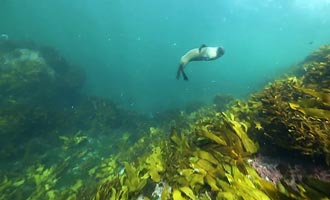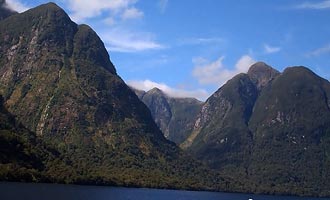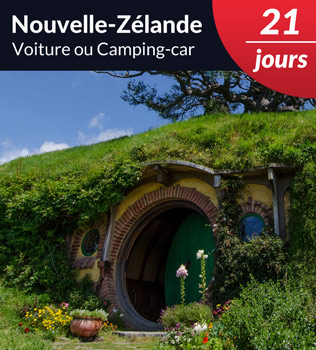
Doubtful Sound, a Fjord at the End of the World.
Please contact us and we will help you to organize your trip! It's free and without commitment.
- Read the post
- Details
- Advices
Schedule of the Visit.
- 1A Day at Doubtful Sound.
- 2Discover the Legend of Lake Manapouri.
- 3Drive Through an Impenetrable Forest.
- 4Discover a Place That Remained Hidden for Thousands of Years.
- 5Admire Hundreds of Waterfalls!
- 6Race with the Dolphins.
- 7Even the Rain Is Your Friend!
- 8A Landscape That Recalls the Lord of the Rings.
A Day at Doubtful Sound.
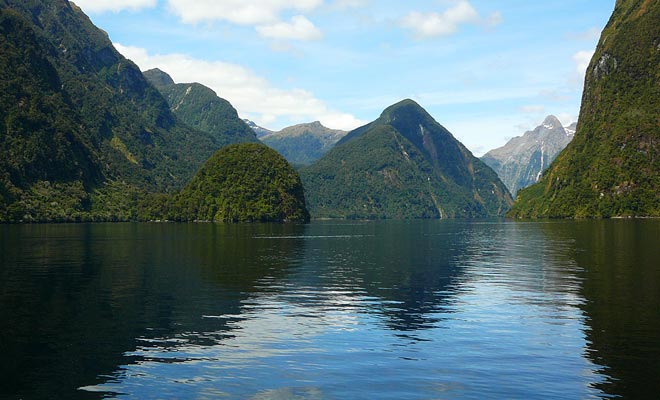
An unexplored fjord for more than 700 years.
In 1770, Captain Cook reach the West Coast of southern New Zealand. He discovers an unknown fjord, with sheer cliffs, lost in the mist.
On the maritime map, drawn day after day, the fjord is named "Doubtful Harbour". A few decades later, the whalers will change the name and call it "Doubtful Sound".

Captain Cook discovered the entrance to the fjord in 1770.
This majestic fjord remained virtually unexplored for almost 700 years. Sir Charles John Lyttelton, former Governor of New Zealand, wrote about it:
There are only a few places in the world where man has never set foot. It seems inconceivable that such a place could exist in a country as civilized as ours...
We were only in 1950, and construction of the first road to the Doubtful Sound had not even yet begun.
This fjord is three times longer and ten times larger than the famous Milford Sound. It will join the UNESCO world heritage in 1990.
Most New Zealanders were even unaware of its existence.
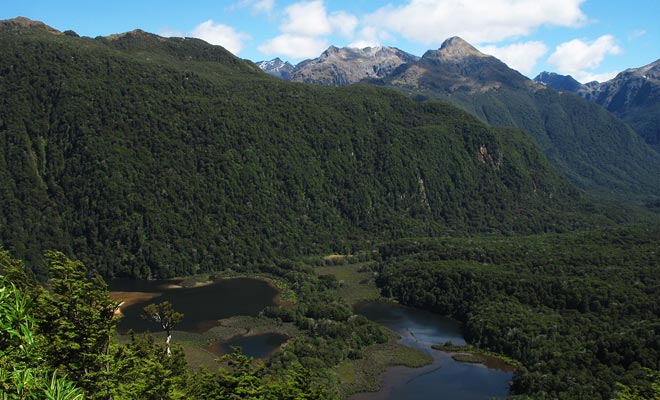
The relief of the Fiordland makes access practically impossible.
To see one of the world's most beautiful scenery, you will have to take many roads, and go around obstacles as well. The full-day trip lasts about 8 hours. An itinerary which requires several alternate transports, by land or sea.
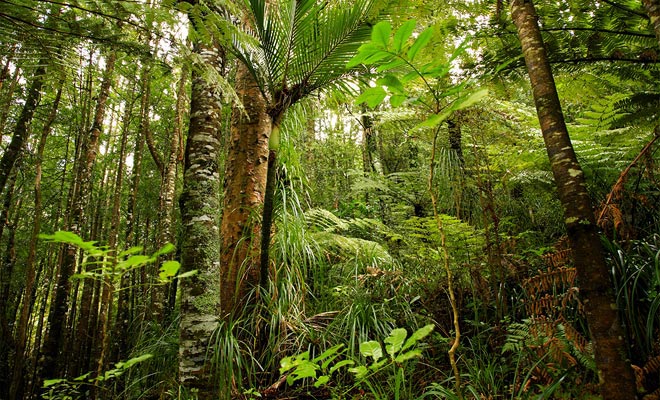
The rainforest is an impenetrable wall.
If you have the soul of an explorer, you can contemplate the Doubtful Sound with your own eyes. With the feeling of having discovered an intact nature, where wildlife has been preserved for thousands of years.
Discover the Legend of Lake Manapouri.

Lake Manapouri is the first stop of the day.
The adventure begins at Pearl Harbor, a port located on a shore of Lake Manapouri. This is the base camp for excursions to Doubtful Sound.
This will be our first step of the journey and one of my first favorites. At dawn, the sun colors the lake with its golden rays.
Legend says that the two daughters of a Maori chief were lost in a forest. One of them was seriously wounded after a fall.
Her sister refused to abandon her, and their tears gave birth to Lake Manapouri.
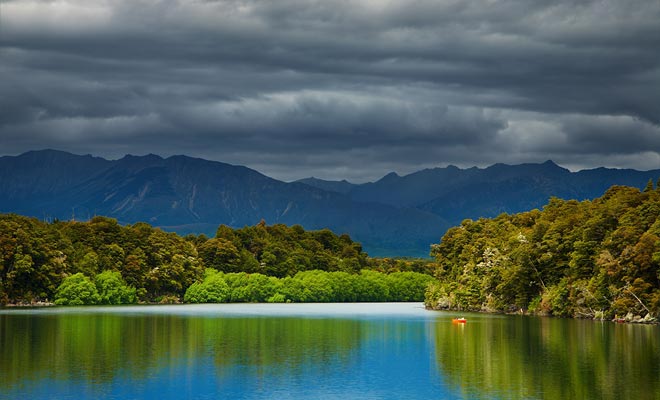
The islands of the lake were condemned to disappear ...
Let's embark on the ship to cross the lake. Once off the shore, the panorama is even more spectacular.
Surrounded by snow-capped mountains, the lake of 142 km2 has 34 islands covered with forests. But this dream landscape was close to disappear…
Let us go back in time until 1959. Back then, it was originally planned to flood the valley to create a dam.
The level of the lake would have increased by more than 30 meters, engulfing the islands and forests.
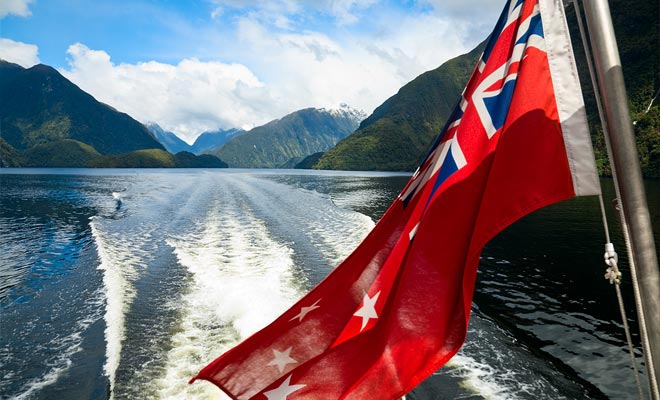
A national petition put an end to the dam project.
It's the entire ecosystem that would have been destroyed, to produce electricity.
More than 265,000 New Zealanders signed a petition to prevent a major environmental disaster. Forced to give up, the government revised its plans, and the flood project was abandoned.
Protecting the environment became a national cause.
Even today it is not uncommon to see the government refusing the exploitation of natural resources, due to the pressure of public opinion.

An underground power plant has been dug in the mountain.
The crossing of the lake takes about one hour. The mountain that rises before us seems unbridgeable. However, we must pass through to reach the Doubtful Sound.
Drive Through an Impenetrable Forest.
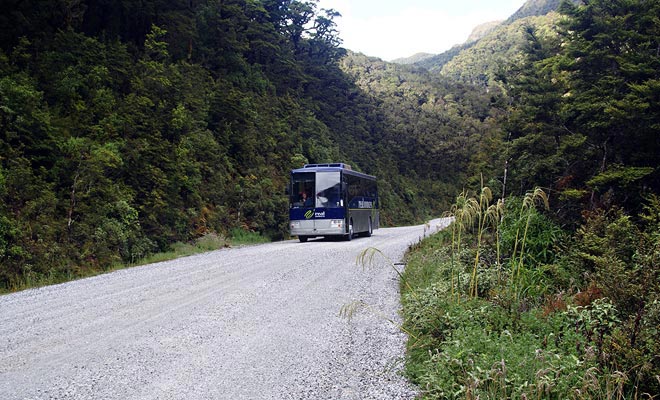
You have to get to Wilmot Pass by coach.
The unique mountain road of the region winds to reach the Wilmot Pass. The rain begins to fall, but we are sheltered in a warm and comfortable bus.
It is the driver who will be our guide during the trip. Cheerful, he sometimes takes the time to stop, giving explanations about the forest wonders. The foam even covers the trunks of trees. Ferns occupy any space. It is a green wall, impenetrable.
It took courage to first travelers to make their way in such a wild and impracticable environment.
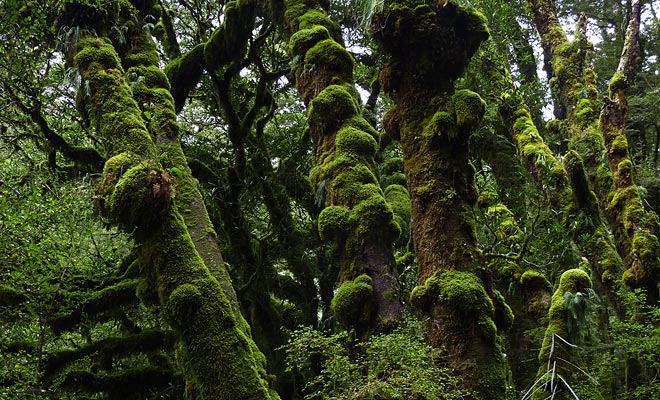
Building a road in the midst of this vegetation was a feat.
The road construction in itself has beaten all records. Imagine an exorbitant cost of two dollars per square centimeter (eight times more than expected). The first three months of work have been a true hell under a continuous downpour.
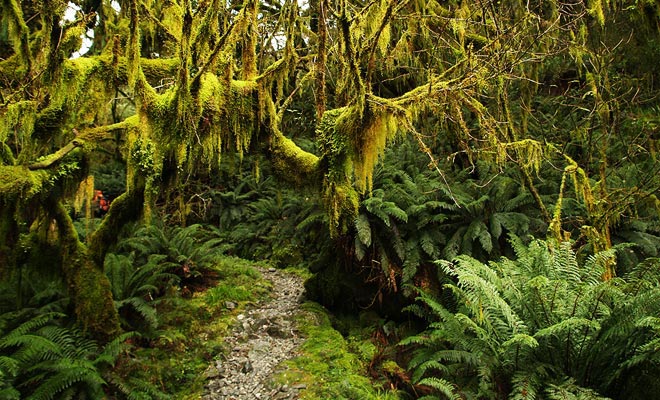
Every square centimeter is covered with damp foam.
We arrive at Wilmot Pass (670 m above sea level) which gives access to the other side of the mountain. This stopover possesses the first observation deck on the Doubtful Sound.
About fifty years ago, only a few adventurers could enjoy such a panorama.
Cleve Garth Falls gush from the top of a rocky ridge. They fall from 365 meters. In the distance, you can contemplate the magnificent Doubtful Sound.
An old dead tree adds a dramatic note to the location. Nature has composed a unique landscape, perhaps the most beautiful and wilderness of New Zealand.
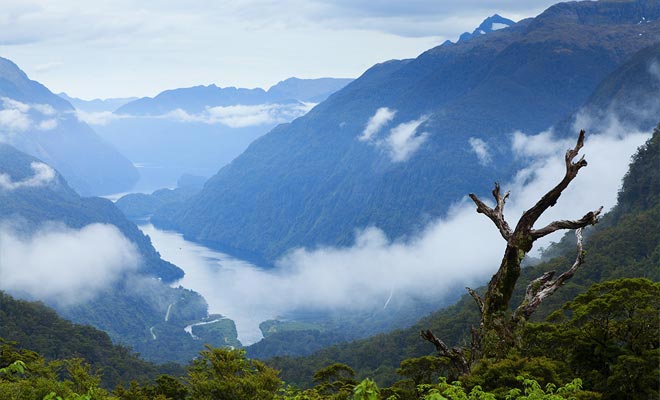
The dead tree of Wilmot Pass and the first view over the fjord.
You had probably not expected to make a new friend!
The kea is the only mountain’s parrot in the world. This wonderful bird is also the most intelligent of his kind.
You can expect to see him approaching without fear to beg for food. However, do not make the mistake of giving him anything.
It is a wild bird, and it must remain so for his own good.

Keas are the most intelligent parrots in the world.
Keep in mind that his sharp beak does not make him a playmate. The kea is known to attack sheep sometime.
Stay away and he will direct his attention to his favorite target: the bus. Perched on the mirrors, he gleefully attacks the rubber seals.
I don’t know the reason for this behavior. It will make everyone laugh, except perhaps the owner of the bus…
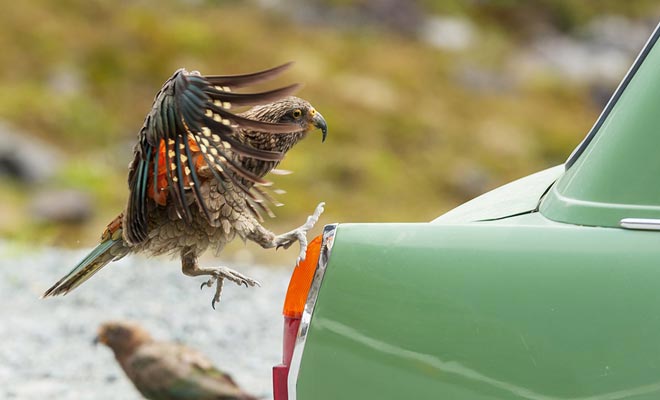
The Keas love rubber seals.
If his Majesty Kea allows us, it's time to go back on the road to reach the dock at Deep Cove.
Discover a Place That Remained Hidden for Thousands of Years.

The whole area was once covered by ice.
Two million years ago, volcanic activity has deformed the earth’s crust. The newly freed space was occupied and expanded by glaciers over millennia.
Gradually, global warming melted the ice. The Tasman Sea rushed into the valley to give birth to Doubtful Sound, a fjord with spectacular dimensions.
The first observation when you arrive at the dock of Deep Cove, is that there is no risk of being disturbed by a crowd of tourists! The other big fjord of the region, the Milford Sound,, is constantly overflown by planes and helicopters.
Here, nothing of a sort, we are virtually alone in the wild nature.
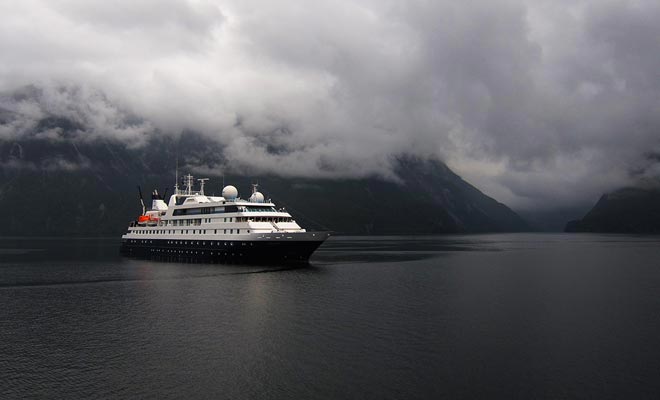
Some cruise ships can sail the fjord.
Only one person lives on-site throughout the year (you have to love the solitude).
A few companies share the tourist exploitation of the fjord. You can choose between a three-hour cruise or the opportunity to spend a night aboard a sailboat. Of course, these two types of travel don’t have the same price...
Our guide Ben the Kiwi will give you all the information on this topic further down in the page.
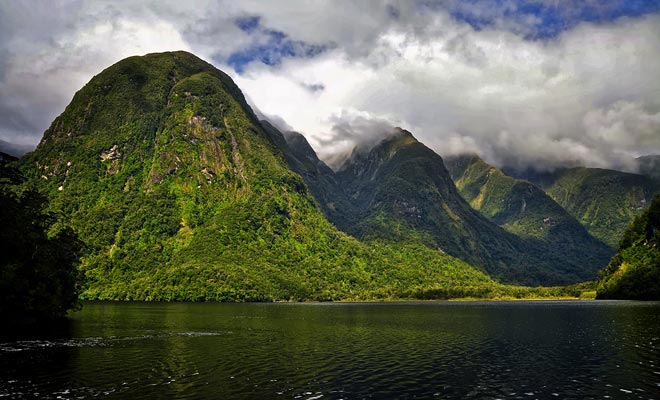
A landscape that could have been in the Willow movie.
Some boats have sails, but they essentially propelled with engines. Captain Cook was right not to venture into these dark waters. Sometimes the wind is not blowing for days, immobilizing ships.
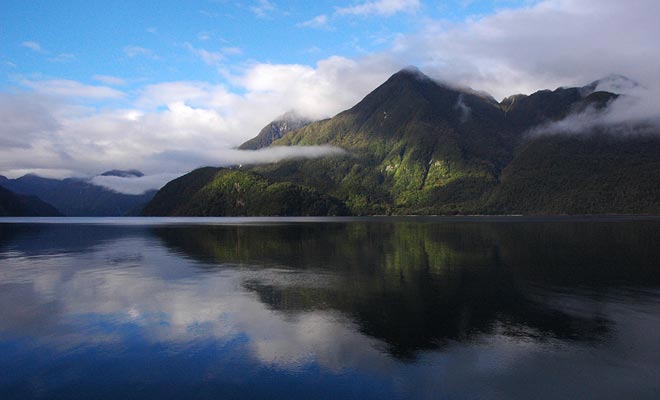
The flat calm can immobilize the sailing ships for days.
Once on board, you should be aware of safety instructions. Depending on the size of the boat, seasickness can be felt. You may consider the usage of medication. Crews are known for their enthusiasm and kindness, do not hesitate to ask their advice during the drip.
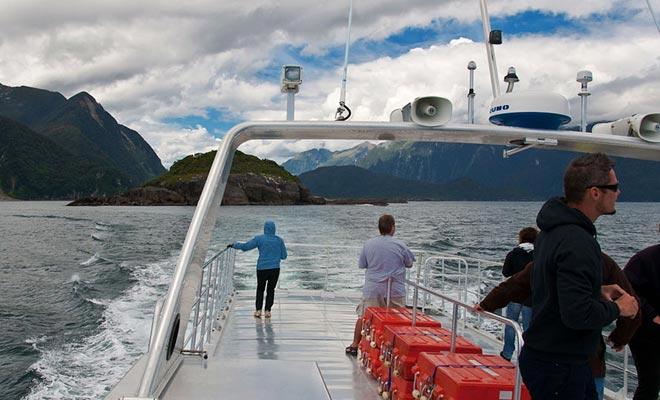
The small boats give more easily sea sickness.
Audio information will be given during the cruise. The rest of the time you can admire the landscape. Depending on the weather, you'll be on the bridge, or sheltered in the cabins. This is the perfect time to enjoy a sandwich. Hot drinks (tea or coffee) are free and served at will!
Admire Hundreds of Waterfalls!
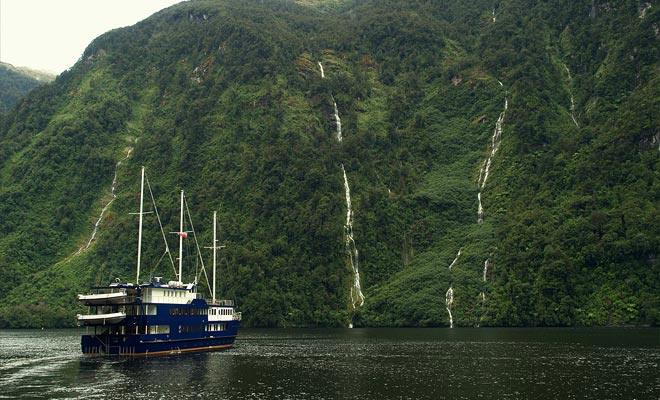
The rain gives rise to ephemeral waterfalls.
Observe the color of the water and you will find that it is very dark. There are two distinct layers which do not mix.
The layer closest to the surface is fresh water deposited by rain. However, a few meters of the surface, we find the salty sea water..
The layers filter the light that does not penetrate deeply. A variety of black coral, that is usually found at 40 meters deep was able to grow here, only a few meters from the surface where divers can easily swim.
On sunny days, the sheer cliffs project their reflection on the black waters of the fjord.
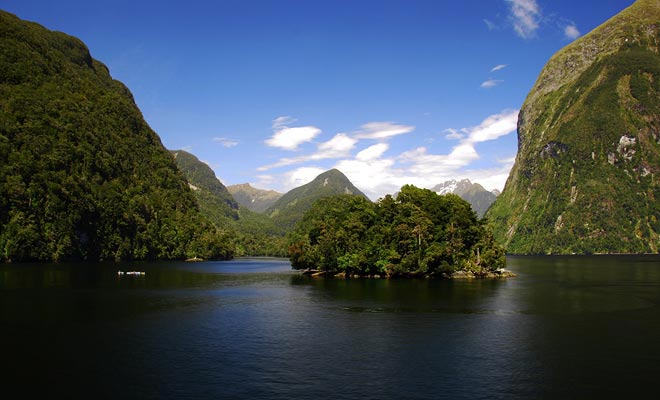
The dark water of Doubftful Sound is due to coral.
Vegetation on the mountainside grows on a layer of very thin soil.
Sometimes tree roots break off. Especially in winter when the snow weight increases the pressure on the branches.
Real avalanches of trees can occur at any moment.
Some cliffs still bear the marks of recent earthquakes.
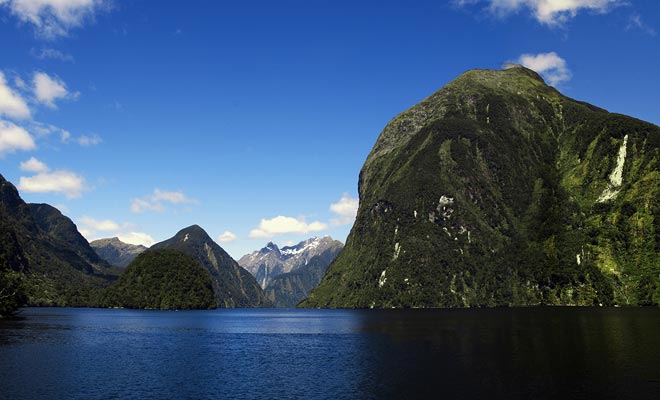
One of the emblematic summits of the Doubtful Sound.
Once offshore, the captain cut the engine for a few minutes. It's an incredible feeling! The Maori name of Doubtful Sound is "Patea", which means "the home of the silence".
The atmosphere is quiet, with only the singing of birds and the distant sound of water falling from the cliffs.
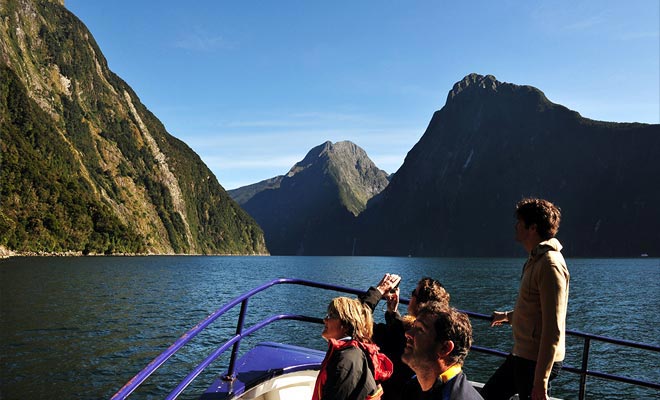
The absolute calm is impressive when you cut the engines.
You can always try to count the falls and cascades ... In rainy weather, there are about 500! Helena Falls, close to Deep Cove, is falling a distance of 220 meters.

Helena Falls and its abundant steam.
Much more impressive, Browne Falls is located in the Hall branch (on of the many fjord branches).
With 836 meters in height, it is the 9th highest waterfall in the world.
Most of the cascades have not been mapped. Nothing prevents you to name the one you like the most.
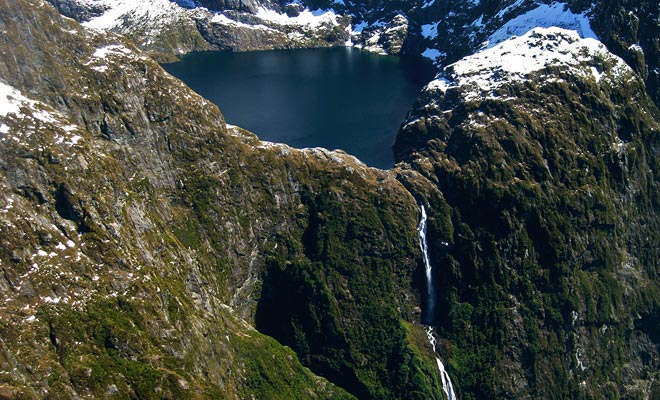
Browne Falls is the 9th highest waterfall in the world.
Your friends who didn't have the courage to come will console themselves by looking at your pictures of the many rainbows. But they will be even more disappointed to have missed the rest of the trip.
Race with the Dolphins.

The dolphins venture into the dark waters.
Contemplating the waterfalls, you've surely noticed the albatross flying over the ship. Their technique is to dive into the water to catch subtropical fishes.
Other species populate the waters of the fjord. If you have decided to spend one night on board, you can taste some lobster or crayfish caught next to the starfish.
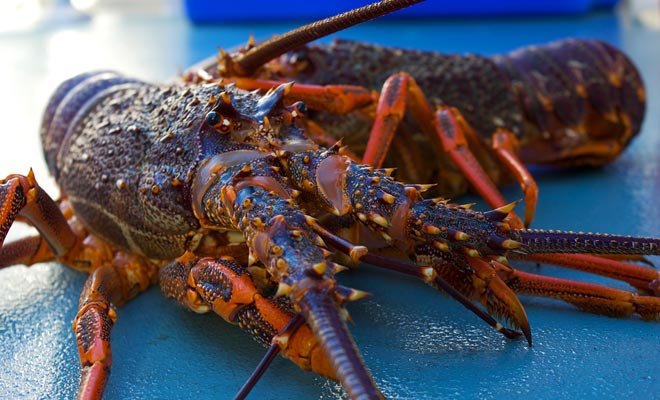
If you spend the night on board, you will taste the lobsters.
You may be lucky enough to spot dolphins near Malaspina Reach.
Few years ago, the dolphin number was close to 70. Without any obvious reason, the dolphin group is now of approximately forty members. We cannot exclude that tourism is the real cause of the decline.
Hence the prohibition for the tourism ships to approach certain parts of the fjord.
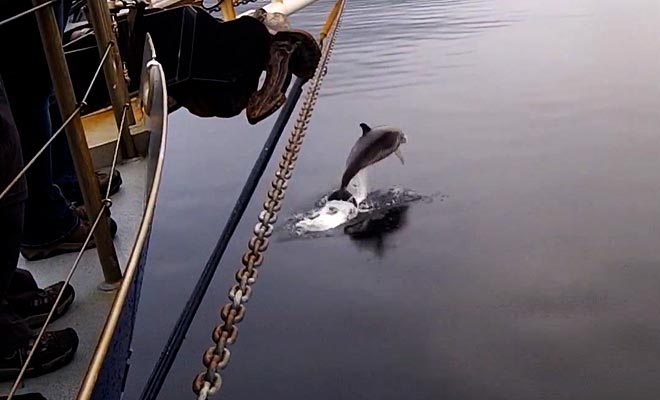
Dolphins often race with ships.
Therefore, if our captain spots dolphins, he will signal their presence to us, but he is not allowed to change the ship direction for this sole reason. However, if the dolphins voluntarily choose to swim near the boat, this is not a problem.
On my last trip, I could admire a dolphin and her baby trying to do a race with our ship.
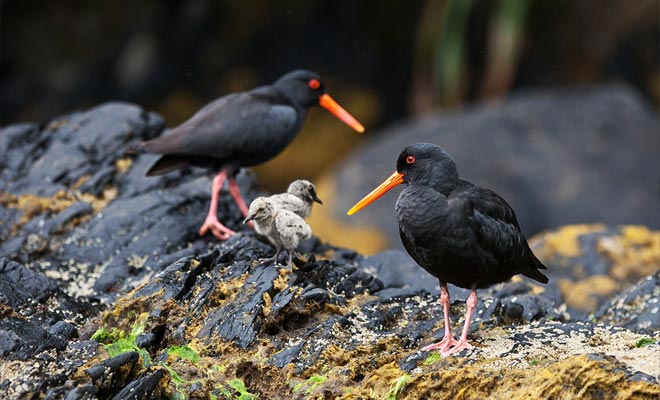
A touching sight, oystercatchers and their nestlings.
To my knowledge, this is the only place in the country where you can observe dolphins (up to 4.5 m). These wonderful creatures can be admired all over New Zealand, but you will most often see Hector dolphins, a much smaller species.

The boat turns back when it reaches the Tasman Sea.
On a clear day, the vessel seems to glide across the water. You'll probably have enough time to reach the Tasman Sea before turning back.
Several whale species are likely to come your way. Orcas are sometimes present, but more difficult to observe.
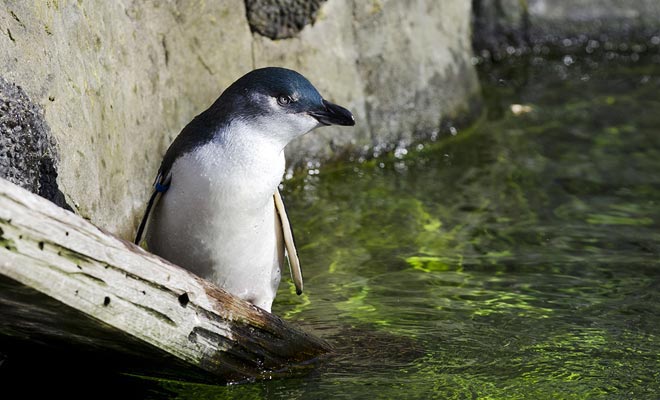
The blue penguins occupy the beach for much of the year.
Pay attention to the foot of the cliffs. The blue penguins are very shy, but easy to spot when they climb on the rocks. Your chance to take a good picture will increase if you use the burst mode of your camera. These adorable creatures have the ability to move at the very moment when you press the shutter button of the camera.

But the fur seals sleep in evidence on the rocks.
The sea lion colonies are easier to spot. They come to bask in the sun on the rocks near the Tasman Sea. If you have enough time during your trip, a kayaking tour on the Fjord allows to observe the sea lions without disturbing them. Paddling alone in the morning fog, in absolute tranquility is an unforgettable experience.
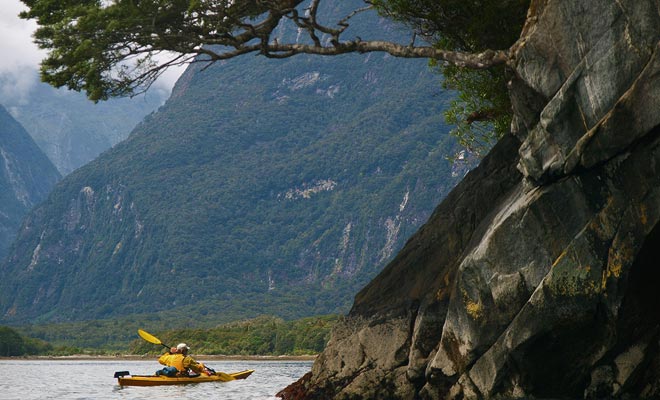
The kayak allows to explore the fjord in an absolute calm.
The bravest may swim if the weather is hot enough. I confess I have never tried. Wait a moment before making fun of me! Fishermen often find small white sharks in their nets! This shark specie is afraid of humans, but I would not dare leaving my toes in the water.
Even the Rain Is Your Friend!
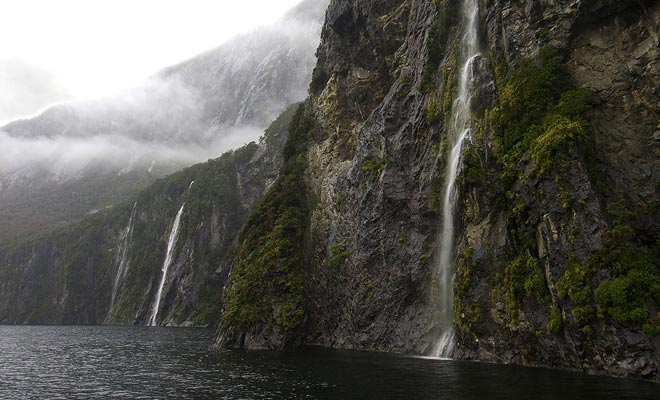
The ideal weather to explore the fjord is just after the rain.
In this region of New Zealand, we usually say that it rains twice a week: a first time during three days, and a second time during four days!
Jokes aside, you can expect an average of 200 days of rain a year... Imagine 6 or 7 meters of precipitation flowing each year (with a record of 67 days of continuous rain). It's not a big surprise if every square centimeter of the mountains is covered with a thick layer of green moss.
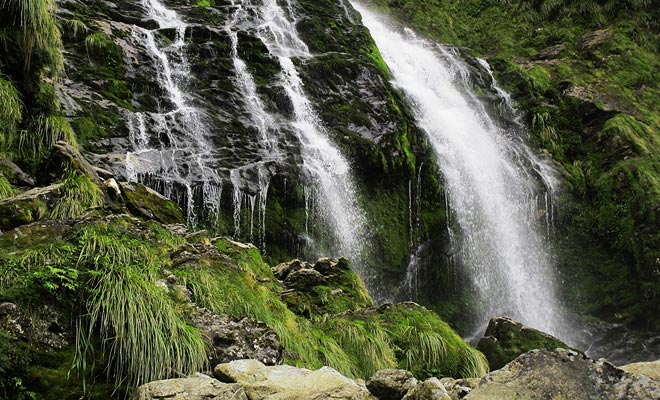
The hundreds of waterfalls disappear with the good weather.
The extraordinary falls are fading when the sun returns, making us almost regretting the rain.One must understand that this is the price to pay to contemplate such a wonder of nature. Bad weather is not to fear during this trip, it is even desirable!
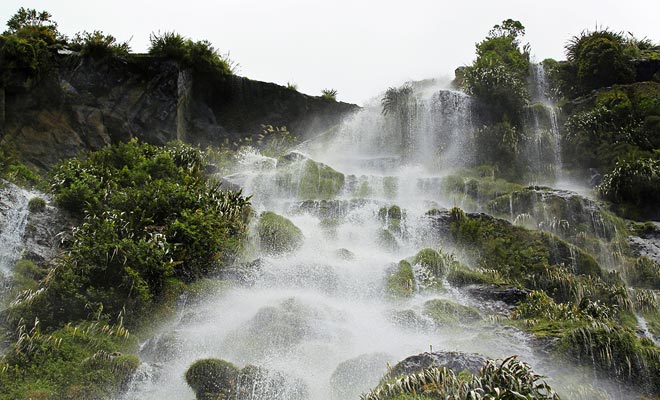
Fortunately, it rains most of the time!
A warm sweater, a good wax: that's all you need.The vessel is fast and a strong wind may blow. Bring your best cap to keep your ears warm. Most of the time, you’ll be on the deck but you can hide in the cabin if necessary. The weather varies from one extreme to another, do not be discouraged.
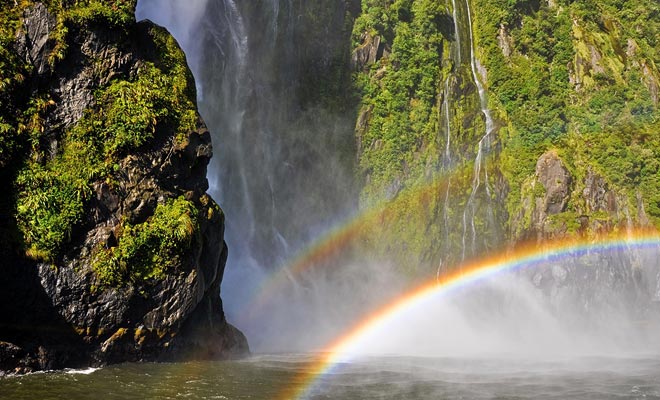
The slightest thinning brings forth countless rainbows.
If you need one reason to endure the rain, here is the best one. The sandflies, these microscopically small flies are your only true enemy in this region. The bites itch and leave red marks on the skin for several weeks.
Maori say that the God Tu-te-raki-whanoa is at the origin of Doubtful Sound. But his creation was so perfect that men were just staring at the landscape and the mighty God had to create sandflies to make them move.
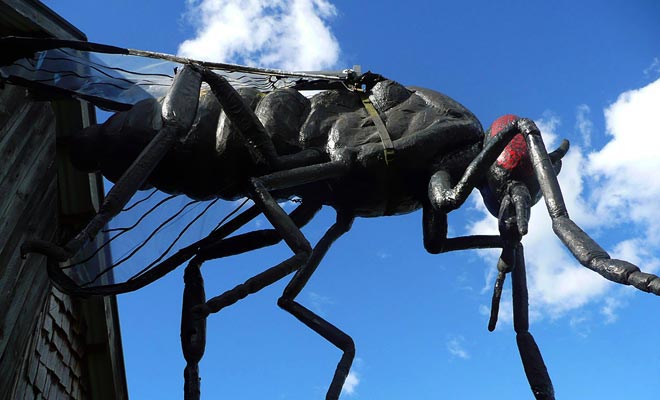
I strongly doubt that the sign of this hostel attracts customers.
The weakness of these demons is their extreme slowness. They are unable to sting moving targets. Sandflies fear the rain, but will return as soon as the rain stops (except during winter).
I advise you to use a repellent before leaving in the morning (you can buy some in Manapouri) and you'll be protected for the rest of the day.
Many tourists complain about sandflies all day long. What eventually ends up annoying the inhabitants of the region.
So, keep smiling and remember that in this fabulous country, there are no snakes and even spiders are rare, which is already extraordinary.
A Landscape That Recalls the Lord of the Rings.
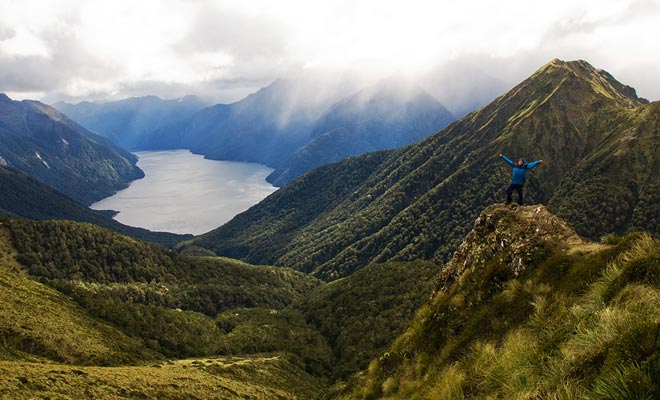
The wildest fjord in New Zealand.
Doubtful Sound deserves its high reputation. Peter Jackson would have gladly filmed the Lord of the Rings in this location if the access was not so difficult.
It's a long day of travel, but it's one of the best tours of the country. The trip itself is amazing and you will come back with an incredible number of pictures.
I am often asked whether to prefer the Milford Sound or the Doubtful Sound in New Zealand. It’s a difficult question. Milford Sound is probably more contrasted with narrow cliffs and a road which is magnificent. But the Doubtful Sound is broader, more varied with dense vegetation and far more peaceful.
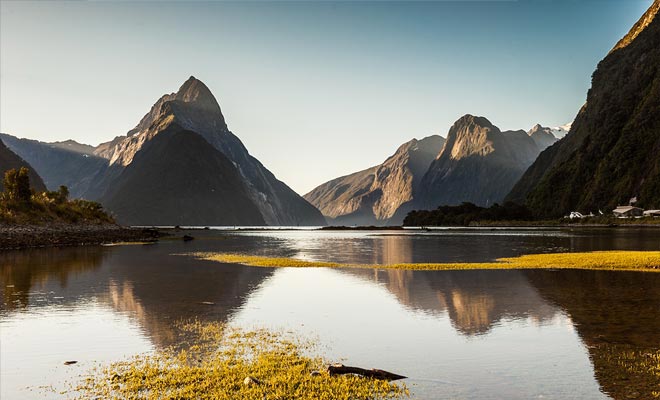
Milford Sound is the country's iconic fjord.
If you must choose, I recommend you check the weather and your wallet first. Remember that the rain is not your enemy. However, the mist can put the expedition in jeopardy. I don’t suggest to book this activity several months in advance.
You may book the excursion only the day before, depending on the weather.
Considering the high price, and the distance, the place is never crowded. Even in summer, you should be able to find a place at the last minute.
Of course, last-minute bookings expose yourself to find no seats. But the proximity of Te Anau offers many alternatives such as Milford Sound or the glowworm caves.

A show reserved for a privileged few.
But during the low season, it is not uncommon to travel in the company of a dozen people only.
You do not come here by chance, you have to be motivated and passionate by nature. This is an opportunity to make beautiful encounters. In winter, the price of the excursion is much cheaper, and it rains less often.
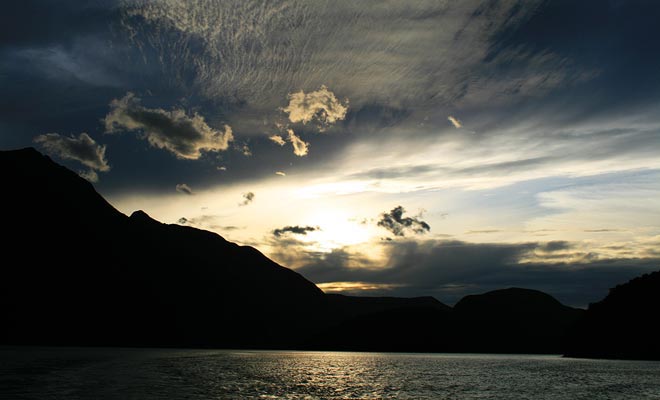
A spectacle reserved for the lucky ones who spend the night on board.
If you can afford it, you should spend a night in the fjord.
You may have the chance to observe the fjord under the moonlight, follow a kayak tour, go fishing or hiking.
Ben the Kiwi will help you plan your trip. Feel free to send us your best photos. We will publish them on Kiwipal, because we are always delighted to see pictures of our readers in New Zealand!


Questions & Answers.

What can I do for you? I consider the Doubtful Sound to be the most impressive fjord. But the visit is much more expensive than the Milford Sound's (still extraordinary). After all, this is just a matter of budgets.
- All topics ... 30 answers in total
- Conducting the Excursion 7 answers
- The Fjord and its History 7 answers
- Planning the Excursion 5 answers
- Accommodation 4 answers
- Animal Species 3 answers
- Weather 2 answers
- Visit of the Power Station 2 answers
Conducting the Excursion
- Can you summarize the course of the day?
In total, it takes about 8 hours, taking into account the phases of embarkation.
Drive from Te Anau to Manapouri (about 25 minutes).
Boat trip on Lake Manapouri (1 hour).
Bus up to Deep Cove (30 minutes).
Cruise on the fjord (2 or 3 hours according to the formula).
Return trip by bus with the visit of the power station (45 minutes).
Return trip by boat on Lake Manapouri (1 hour). - What type of excursion should you choose?
It all depends on your budget and the style of travel you prefer. Staying overnight allows you to meet new people. If you do not particularly like to make the conversation with other travelers, you may prefer the 3-hour cruise. Spending a night on site implies unforgettable activities, such as kayaking or lobster fishing.
- What is the starting point of the excursion?
The pier is located at Manapouri Lake, Pearl Harbor Harbor. But there are shuttles from Te Anau (25 minutes) and Queenstown (2 hours 30 minutes).
- Is it crowded?
In summer, cruise ships are sometimes fully booked. In this situation, one can feel a little cramped on board. But that seems to me quite tolerable and it is rare that travelers fill a complaint. Moreover, unlike the Milford Sound, there are fewer people there.
- Do children enjoy this kind of visit?
Generally, toddlers do not like this type of visit very framed with a lot of transport. They quickly get tired of the landscape.
- Can the Doubtful Sound be reached on foot?
From Deep Cove you will find several hiking trails including the Old Doubtful Sound Track which was the only access road before the construction of the modern road. It is a hike of 3h (round trip) over a distance of 2.7 km. It joins the road to Wilmott Pass, and does not allow to reach Lake Manapouri.
- Are there any hikes near the Doubtful Sound?
If you are staying at Deep Cove Hostel, you can explore four hiking trails. Ask for a brochure on site. Hanging Valley Track is usually traveled by schoolchildren, and should not cause you any problems. A second hike takes you to the Helena Falls, opposite the Doubtful Sound. The third excursion is the famous "Old Doubtful Sound Track", once the only access road to the Fjord. A fourth and last trek "Brasell Point Track", favors the study of the fauna and flora.
The Fjord and its History
- Who discovered the Doubtful Sound?
The Maori gave it the name of Patea ("the place where silence reigns"). The discovery by the Westerners dates from 1770, with the arrival of Captain Cook who baptizes it "Doubtful Harbor". The captain dared not venture farther, for fear of not being able to turn back. They will be Spanish scientists who will carry out the first mapping of the fjord in 1793. This explains the names with Spanish connotation on the cards (Febrero Point, Bauza Island, Pendulo Reach or Malaspina Reach ...)
- What is the meaning of « Sound »?
Originally, the word "sound" refers to an arm of the sea, formed by the submersion of a valley. The Doubtful Sound is wrongly named because it is actually a Fjord, just like the Milford Sound.
- What is the Fiorland?
It is a region of New Zealand with 14 fjords (including the Doubtful Sound and the Milford Sound) and 5 large lakes. Registered as a UNESCO World Heritage site in 1990, it covers nearly 1.2 million hectares, two thirds of which are covered by temperate rain forests. Some Australian beeches and various Podocarpus are over 800 years old. The vegetation is dense, and the heavy precipitation makes this area as beautiful as it is often impracticable. Over time, nearly 500 kilometers of trails have been traced and need to be maintained regularly.
- What is the name of the big island near the Tasman Sea?
It's Secretary Island. High of 1200 meters, it occupies 81 km2. A campaign has begun to eliminate all predators on the island to create a bird sanctuary.
- What are the names of the different arms of the fjord?
They are known as First Arm, Crooked Arm (midway through the fjord), and Hall Arm (which joins Deep Cove).
- Where can we see the Hares Ears?
These two rocks resemble Sidney's opera, when viewed from a certain angle. You can observe them when the ship approaches the Tasman Sea. The captain will tell you during the journey.
- Why is the water so dark?
Because of a variety of black coral (antipatharia fjordensis) that develops at the bottom of the water.
Planning the Excursion
- How much does an excursion to the Doubtful Sound cost?
You will need about $275 per adult, and $60 per child if you travel with Real Journeys. Supplements apply if a shuttle bus is required to pick you up at Te Anau or Queenstown. Rates are subject to change depending on season and company. I recommend you to consult the rates directly on the websites:Fiordland Adventure
- Should we come from Queenstown or Te Anau?
I would not recommend coming directly from Queenstown! One must remember that the visit to the Doubtful Sound last 8 hours. Traveling from Queenstown would add an extra 2 hours 30 minutes' drive. It would extend the total tour duration to 13 hours, mostly in transportation! You'll end up exhausted. On the other hand, coming from Te Anau only adds a 25 minutes drive.
- Is there a car park in Manapouri?
It's free. Most people agree that it is safe enough to leave luggage in the trunk of the car. But I recommend leaving them at the hotel, unless you cannot do otherwise.
- Is it necessary to bring food?
Most companies include a lunch pack for an additional cost. A practical solution if you are pressed for time. You can also buy sweets in addition on the boat. If you have subscribed for the visit with one night on site, meals are included. In general, they are both hearty and delicious (excellent muffins).
- Are mobile phones working in the area?
At the power plant level, the phones can work, but on the fjord they will lose the signal.
Accommodation
- Can we spend the night in Manapouri?
This small village has a few holiday houses, a restaurant-bar and a dozen accommodations. It will do the trick if you want to avoid taking a shuttle or following the road from Te Anau.
- Can we camp there?
There are no campsites nearby. In the absence of camping, you can stay at the Deep Cove Hostel (subject to availability). Normally reserved for school groups, this hotel is open to everyone during the school holidays, between December and February (expect to pay a price between $25 and $40).Deep Cove Hotel
- What clothes should we bring to spend the night on board?
The cabins are comfortable, but small. One must be satisfied with the strict minimum, which means bringing warm clothes. Consult the tour operator for the amount of luggage permitted.
- Is it easy to sleep on a boat?
The engines are stopped at night, and the fjord is faithful to its reputation: quiet and silent. However, sleeping on a boat is not an obvious experience for everyone. Some are lulled by the movement, others do not appreciate much. In my opinion, the waters are far too calm for someone to be sick.
Animal Species
- Which kind of whales can be seen here?
With some luck, you can spot Southern whales, humpback whales, and sperm whales.
- What are the chances of seeing dolphins or whales?
Do not forget that this is a natural reserve and not a zoo. It is impossible to guarantee an encounter with the different species.
- What is Takahe?
It is a species of colored bird threatened with extinction. Unable to fly, he was considered to be extinct, but he survived in the Fjord. You may be lucky enough to photograph it.
Weather
- Where can I check the Doubtful Sound weather forecast?
Check out this page for weather forecasts:Doubtful Sound Weather
- Is it necessary to take an umbrella?
On the boat, it would be totally useless considering the strong wind. It is better to wear a wax.
Visit of the Power Station
- How does the visit to the power station take place?
The power plant project was created to replace the original project, which was to merge lakes Manapouri and Te Anau. The power plant was dug in the granite, at 213 meters deep, under the mountains of West Arm. To reach the room of the turbines, one descends by coach in a spiral tunnel 2 km long. Not less than 1800 workers have worked on this site. The electricity produced is used to supply an aluminum smelter, located at Bluff, 171 km to the south. This is an original visit that may not appeal to everyone, however.
- Am I obliged to visit the power station?
You can ask to wait outside. Do not go too far not to miss the bus on his return from the power plant visit.
On the Country Map
The Doubtful Sound is located in a part of the Fiordland, at the south-west of the South Island.



